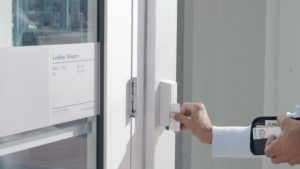Some may violate ADA, fire prevention codes
Ever since Sandy Hook and other school shooting tragedies, entrepreneurs have introduced a variety of after-market devices designed to secure classroom doors.
That’s because most classroom doors open into hallways and have locking mechanisms that lock from the outside. To protect teachers and others from potential exposure to hallway violence, well-intentioned vendors have invented products to eliminate that risk.
Many have beneficial features worth reviewing; however, if not carefully selected, there may be inherent risks with those products.
Beware: magnets, barricades, and sleeves
Magnets are placed over door frame strike plates to prevent door locks from latching. The classroom door is always locked without affecting operations because students and staff can freely come and go. In a violent emergency, teachers do not have to use a key to lock the door. They simply remove the magnet and the door latches.
 Unfortunately, a teacher can forget to remove the magnet in an actual emergency. If the door is closed, they must open the door to remove the magnet. In addition, a student or intruder can also remove the magnet when the teacher is out of the classroom. Because teachers who utilize door magnets tend not to carry keys, they can be locked out of their own room.
Unfortunately, a teacher can forget to remove the magnet in an actual emergency. If the door is closed, they must open the door to remove the magnet. In addition, a student or intruder can also remove the magnet when the teacher is out of the classroom. Because teachers who utilize door magnets tend not to carry keys, they can be locked out of their own room.
A barricade is a security device designed to impede doorway entry. It is a rectangular-shaped plate of 7/8 inch thick cold-rolled steel with steel pins and a floor mounted steel sleeve that when fully engaged can withstand 16,000 pounds of pressure.
Barricades are marketed as the only door barricade that meets egress law requirements, utilizing a patent-pending release mechanism for safety officers or emergency personnel to enter and secure a room. This patented technology reportedly allows officers to enter the room in seconds. The barricade is placed on the inside of classroom doors and drops two steel pegs into holes in the threshold to prevent the door from being opened.
A sleeve is a steel case that slides over the classroom door’s closer arm, securing the door from the inside. Numerous similar products join the mix of after-market devices designed to secure classroom doors at a fraction of what it would cost to replace existing door locks with mechanisms that lock from the inside (classroom security locks).
After-market product suppliers often tout the cost disparity between a $7.99 magnet and a $250 lock. If the average school has 50 classroom doors, the multiplier presents a convincing argument. Some vendors even imply that insurance providers will offer premium discounts to those that purchase such devices. School officials would be wise to challenge these firms to provide a concrete example of a school that has indeed received a premium discount.
Local law enforcement officials account for the stakeholder group most likely to endorse these inventions. But door hardware manufacturers would never endorse, let alone produce, these after-market solutions because many of these products tend to violate National Fire Protection Association (NFPA) egress codes and Americans with Disabilities Act (ADA) codes.
In addition, most of these solutions require “prior knowledge” to activate. Products that are not attached to doors must be quickly located and correctly deployed. Products that are attached to doors void door hardware warranties. Perpetrators can use these kinds of devices to keep authorized individuals out.
Some schools have installed these inexpensive solutions only to find out that code violations require their removal. Involve fire marshals, door hardware manufacturers and insurance providers before investing in after-market solutions.
Best advice: consult an expert
The door barricade issue highlights the larger challenge of how schools and universities select the safety and security solutions and policies they implement. It is critical for a school district to hire vetted and qualified security consultants, systems integrators, engineers and other vendors for guidance on this task.
These professionals should have experience working on your type of campus or organization. For example, a K-12 district should probably consult with an expert in school security. A university wanting to be able to quickly lockdown its classroom doors should consult with a professional who fully understands ADA and NFPA codes.
It’s important to note that every security and public safety solution and policy — even if it is ADA and NFPA code-compliant — carries with it some risk.

